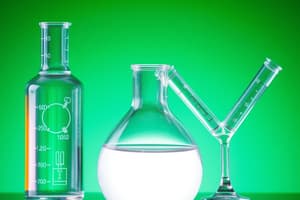Podcast
Questions and Answers
What is the author's recommendation for using this study guide?
What is the author's recommendation for using this study guide?
- To skip the questions and only read the study guide
- To look at the answer key before attempting the questions
- To do one question and then look at the key before moving to the next question
- To do all the questions in the booklet (correct)
How does the author suggest learning from mistakes?
How does the author suggest learning from mistakes?
- By avoiding group study sessions
- By discussing difficulties with a study partner or peer tutoring group (correct)
- By ignoring the mistakes and moving on to the next question
- By not identifying why a question was answered incorrectly
What does the author recommend not doing while using the study guide?
What does the author recommend not doing while using the study guide?
- Looking at one answer in the study guide
- Looking at the answer key before attempting any questions (correct)
- Skipping the questions and only reading the study guide
- Doing all the questions
According to the author, what will reduce the effectiveness of using this study guide?
According to the author, what will reduce the effectiveness of using this study guide?
How does the author recommend using this study guide with other students?
How does the author recommend using this study guide with other students?
What does the author emphasize about the composition of questions from year to year?
What does the author emphasize about the composition of questions from year to year?
Which of the following units can be used to express the rate of a chemical reaction?
Which of the following units can be used to express the rate of a chemical reaction?
Consider the following reaction: The rate of formation of NH3 is 3.0 mL/min. The rate of consumption of H2 is
Consider the following reaction: The rate of formation of NH3 is 3.0 mL/min. The rate of consumption of H2 is
At a certain temperature, the rate of decomposition of N2O5 is 2.5 × 10^-6 mol/s. The rate of formation of NO2 is:
At a certain temperature, the rate of decomposition of N2O5 is 2.5 × 10^-6 mol/s. The rate of formation of NO2 is:
Under certain conditions, the rate of decomposition of NO2 is 3.2 × 10^-3 mol/s. The rate of formation of O2 is:
Under certain conditions, the rate of decomposition of NO2 is 3.2 × 10^-3 mol/s. The rate of formation of O2 is:
The rate of a chemical reaction can be expressed in:
The rate of a chemical reaction can be expressed in:
Consider the following reaction: The rate of this reaction can be expressed as:
Consider the following reaction: The rate of this reaction can be expressed as:
Which unit represents the rate of formation or consumption in a chemical reaction?
Which unit represents the rate of formation or consumption in a chemical reaction?
In the context of chemical reactions, what does the term 'rate' usually refer to?
In the context of chemical reactions, what does the term 'rate' usually refer to?
Which of the following units represents the rate of a chemical reaction?
Which of the following units represents the rate of a chemical reaction?
Consider the reaction: At a certain temperature, the rate of decomposition of N2O5 is 2.5 ×10^-6 mol/s. The rate of formation of NO2 is:
Consider the reaction: At a certain temperature, the rate of decomposition of N2O5 is 2.5 ×10^-6 mol/s. The rate of formation of NO2 is:




